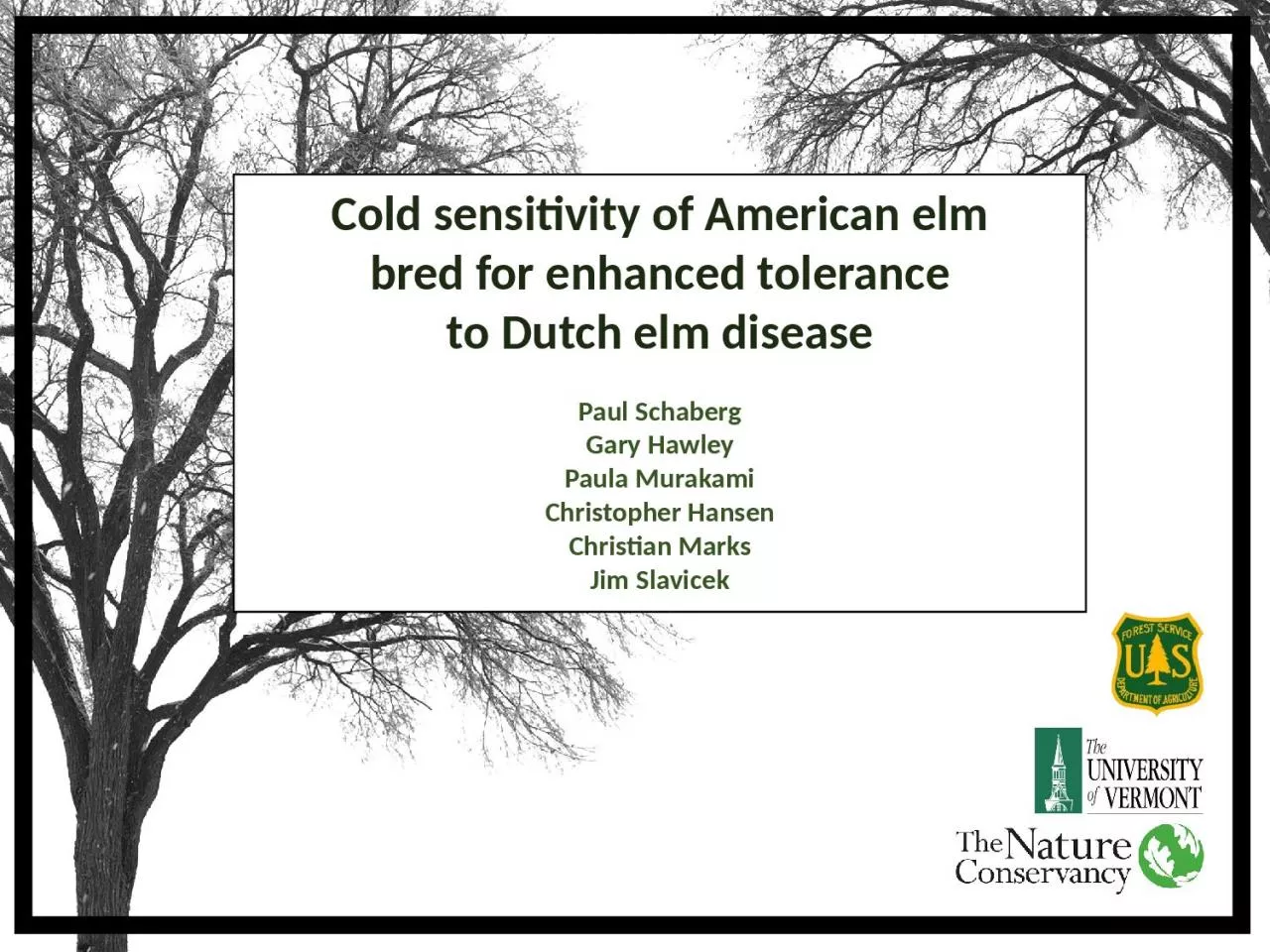

bred for enhanced tolerance to Dutch elm disease Paul Schaberg Gary Hawley Paula Murakami Christopher Hansen Christian Marks Jim Slavicek Important component of floodplain and riparian ID: 1045162
Download Presentation The PPT/PDF document "C old sensitivity of American elm" is the property of its rightful owner. Permission is granted to download and print the materials on this web site for personal, non-commercial use only, and to display it on your personal computer provided you do not modify the materials and that you retain all copyright notices contained in the materials. By downloading content from our website, you accept the terms of this agreement.
1. Cold sensitivity of American elmbred for enhanced toleranceto Dutch elm diseasePaul SchabergGary HawleyPaula MurakamiChristopher HansenChristian MarksJim Slavicek
2. Important component of floodplain and riparian forestsVast range with varied species assemblages Support range of ecosystem services – carbon sequestration, water and nutrient cycling, wildlife habitat, etc.Wood – strong interlocking grain, furniture, flooring, boxes, baskets, hockey sticks, wood pulp, paper, etc.American Elm (Ulmus americana)https://www.wood-database.com/american-elmPhoto courtesy of Jim Slavicek, USDA
3. Distinct vase-shaped crownHigh tolerance to salt and other stressesThe most common urban tree in North AmericaUntil drastic population declines associated with…Urban ForestsPhoto by Louis L. McAllister, http://www.uvm.edu/~hp206/2006/Mardorf/WEB/Pearl5.htmlLooking west toward Lake Champlain at intersection of Pearl St. and Church St. in 1934
4. Dutch Elm Disease (DED)Vascular wilt disease caused by fungal pathogensOphiostoma ulmi and Ophiostoma novo-ulmi Spread by native and European bark beetlesBeetles burrow into stem carrying sporesFungi grow and spread in vasculatureClogs xylem - restricts water transportLeaf desiccationBranch diebackCrown deterioration and tree death
5. Dutch Elm Disease (DED)Non-native of Asian originFirst reported in US in 1928Fungi in veneer logsInitial quarantine Slow spread up until WWIIRapid spread in 1950s-1970sBy 1989 >75% of estimated 77 million elms in North America killed
6. DED ControlMechanical – pruning and burningChemical - insecticides for beetle control - pheromones to lure/trap beetles - fungicides (e.g., Arbotect and Alamo)Biological – vaccination with weakened Verticillium albo-atrum to bolster immune responseBreeding for DED tolerance - Hybrids with Asian elms resistant to DED - Selection for DED-tolerant American elm - ± 25 cultivars, but not much genetic diversity for restoration across broad range
7. Cross DED tolerant American elm cultivarsLarge survivor elms from many locationsTest for DED-tolerance and local adaptationUS Forest Service NRS / TNC PartnershipSam Burr Elm, Vermont, USA
8. Wide range of conditions: - temperatures - water regimes - soils - vegetative communities - etc.Local adaptation?
9. Winter coldRange from Zone 9b (-1 °C) to Zone 2b (-43 °C)
10. Cold hardiness of northern restoration stock? Shoot cold tolerance - Controlled laboratory freezing testsGenetic crosses -Maternal - DED-tolerance - Paternal - different USDA Plant Hardiness ZonesVariation across seasons - fall, winter and springField freezing injury - laboratory measures help resolve differences among sources and seasons but may overestimate tolerance
11. Plant MaterialMaternal sources – Valley Forge and R18-2Paternal sources – large surviving elms in zones 6b, 6a, 5a Field site - Lemington, VT zone 3b Chippewa National Forest, MN zone 3a
12. Field collectionField site Lemington, VT (zone 3b)Planted in 2014Current-year shoots harvested December 2016, February and April 2017Field winter injury assessed in July 2017
13. Laboratory Cold ToleranceShoots chopped into 5-mm segments15-17 test temperatures - from +5°C to –90°CDamage = ↑Relative Electrolyte Leakage (REL)TmK+
14. Parental sources – all dates combinedaabb
15. DCold tolerance resultsaabbΔ mean cold tolerance between 5a and 6a sources was ± 5.5 °C – the average Δ in low temperatures for these zones
16. Field winter injuryWinter temperatures dropped to -28.3 °C Over 83% of trees sampled experienced shoot freezing injuryChippewa National Forest, MN
17. ImplicationsShoot freezing injury is an issue for American elm in the northSource Hardiness Zone a good predictor of elm shoot cold toleranceBreed and plant sources from the local Hardiness Zone or lower Restoration of American elm on Chippewa National Forest in Minnesota
18. Climate change – northern populations possible migration front as climate warmsEmerald ash borer (EAB) is killing ash in region - Decreasing diversity in riparian and floodplain forests - Ash heavily planted in urban settings when DED killed elm - DED-tolerant elm needed for ash replacementElm Restoration and Emerging Threatshttps://vtinvasives.org/invasive/emerald-ash-borerhttps://www.nasa.gov/nasa-global-climate-change-projections
19. Looking north on University Place in 1825http://www.uvm.edu/~hp206/2006/Zanavich/Web%20Pages/U4.htmlQuestions-“American elm - Dutch elm disease,” Omeka@CTL, accessed November 16, 2018, http://ctl.w3.uvm.edu/omeka/items/show/1236.